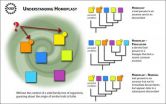New research suggests that obesity and diabetes are a downside of human evolution
New research in the FASEB Journal suggests that a gene called CMAH has been lost during the course of recent evolution, and may lead to an increased risk of Type 2 diabetes in humans
2011-02-28
(Press-News.org) As if the recent prediction that half of all Americans will have diabetes or pre-diabetes by the year 2020 isn't alarming enough, a new genetic discovery published online in the FASEB Journal (http://www.fasebj.org) provides a disturbing explanation as to why: we took an evolutionary "wrong turn." In the research report, scientists show that human evolution leading to the loss of function in a gene called "CMAH" may make humans more prone to obesity and diabetes than other mammals.
"Diabetes is estimated to affect over 25 million individuals in the U.S., and 285 million people worldwide," said Jane J. Kim, M.D., a researcher involved in the work from the Department of Pediatrics at the University of California, San Diego in La Jolla, CA. "Our study for the first time links human-specific sialic acid changes to insulin and glucose metabolism and therefore opens up a new perspective in understanding the causes of diabetes."
In this study, which is the first to examine the effect of a human-specific CMAH genetic mutation in obesity-related metabolism and diabetes, Kim and colleagues show that the loss of CMAH's function contributes to the failure of the insulin-producing pancreatic beta cells in overweight humans, which is known to be a key factor in the development of type 2 diabetes. This gene encodes for an enzyme present in all mammalian species except for humans and adds a single oxygen atom to sialic acids, which are sugars that coat the cell surface.
To make their discovery, the researchers used two groups of mice. The first group had the same mutant CMAH gene found in humans. These mice demonstrated that the CMAH enzyme was inactive and could not produce a sialic acid type called NeuSGc at the cell surface. The second group had a normal CMAH gene. When exposed to a high fat diet, both sets of mice developed insulin resistance as a result of their obesity. Pancreatic beta cell failure, however, occurred only in the CMAH mutant mice that lacked NeuSGc, resulting in a decreased insulin production, which then further impaired blood glucose level control. This discovery may enhance scientific understanding of why humans may be particularly prone to develop type 2 diabetes. Results may also suggest that conventional animal models may not accurately mirror the human situation.
"The diabetes discovery is an important advance in its own right. It tells us a lot about what goes wrong in diabetes, and where to aim with new treatments," said Gerald Weissmann, M.D., Editor-in-Chief of the FASEB Journal, "but its implications for human evolution are even greater. If this enzyme is unique to humans, it must also have given us a survival advantage over earlier species. Now the challenge is to find the function of CMAH in defending us against microbes or environmental stress or both. This evolutionary science explains how we can win some and lose some, to keep our species ahead of the extinction curve."
###
Receive monthly highlights from the FASEB Journal by e-mail. Sign up at http://www.faseb.org/fjupdate.aspx. The FASEB Journal (http://www.fasebj.org) is published by the Federation of the American Societies for Experimental Biology (FASEB) and celebrates its 25th anniversary in 2011. Over the past quarter century, the journal has been recognized by the Special Libraries Association as one of the top 100 most influential biomedical journals of the past century and is the most cited biology journal worldwide according to the Institute for Scientific Information.
FASEB comprises 23 societies with more than 100,000 members, making it the largest coalition of biomedical research associations in the United States. FASEB enhances the ability of scientists and engineers to improve—through their research—the health, well-being and productivity of all people. FASEB's mission is to advance health and welfare by promoting progress and education in biological and biomedical sciences through service to our member societies and collaborative advocacy.
Details: Sarah Kavaler, Hidetaka Morinaga, Alice Jih, WuQiang Fan, Maria Hedlund, Ajit Varki, and Jane J. Kim. Pancreatic β-cell failure in obese mice with human-like CMP-Neu5Ac hydroxylase deficiency. FASEB J. fj.10-175281; doi:10.1096/fj.10-175281 ; http://www.fasebj.org/content/early/2011/02/22/fj.10-175281.abstract
END
ELSE PRESS RELEASES FROM THIS DATE:
2011-02-28
How severe can climate change become in a warming world?
Worse than anything we've seen in written history, according to results of a study appearing this week in the journal Science.
An international team of scientists led by Curt Stager of Paul Smith's College, New York, has compiled four dozen paleoclimate records from sediment cores in Lake Tanganyika and other locations in Africa.
The records show that one of the most widespread and intense droughts of the last 50,000 years or more struck Africa and Southern Asia 17,000 to 16,000 years ago.
Between 18,000 and 15,000 ...
2011-02-28
Cambridge, MA- Adding particles to liquids to make currents visible is a common practice in the study of fluid mechanics. The approach was adopted and perfected by artist Paul Matisse in sculptures he calls Kalliroscopes. Matisse's glass-enclosed liquid sculptures contain an object whose movement through the liquid creates whorls that can be seen only because elongated particles trailing the object align with the direction of the current; light reflects off the particles, making the current visible to the viewer.
Researchers at MIT recently demonstrated that this same ...
2011-02-28
With the genetics of so many organisms that have different traits yet to study, and with the techniques for gathering full sets of genetic information from organisms rapidly evolving, the "forest" of evolution can be easily lost to the "trees" of each individual case and detail.
A review paper published this week in Science by David Wake, Marvalee Wake and Chelsea Specht, all currently National Science Foundation grantees, suggests that studying examples of homoplasy can help scientists analyze the overwhelming deluge of genetic data and information that is currently ...
2011-02-28
Montreal, February 24, 2011 – The interventional cardiology team at the Montreal Heart Institute (MHI) recently began patient enrolment for a new device, the Neovasc ReducerTM, designed to treat patients suffering from refractory angina. The treatment method is a first in North America and is being conducted as part of an international study, the COSIRA trial. This innovative treatment is promising for thousands of Canadians disabled by refractory angina and who lack alternatives for relieving their symptoms and improving their quality of life.
Developed in Canada by ...
2011-02-28
A strong link between victimization experiences and substance abuse has been discovered by researchers at the University of Illinois at Chicago.
The correlation is especially prevalent among gays, lesbians and bisexuals -- more so than in heterosexuals, says Tonda Hughes, professor and interim head of health systems science in the UIC College of Nursing. Hughes is lead author of the study, published in the journal Addiction.
Researchers compared victimization experiences of unwanted sexual activity, neglect, physical violence, and assault with a weapon, across four ...
2011-02-28
ARLINGTON, Va. - One Sailor's request to replace humming fluorescent bulbs with a quiet alternative inspired the Office of Naval Research (ONR) to create the Solid State Lighting (SSL) project, currently being evaluated aboard several ships and submarines across the U.S. Navy.
A product of ONR's TechSolutions program, SSL is one of several rapid-response technologies created using recommendations and suggestions from Navy and Marine Corps personnel. (Watch TechSolutions products in action via YouTube.)
The SSL project introduced the energy-saving, nonhazardous LED ...
2011-02-28
Age alters memory. But in what ways, and why? These questions comprise a vast puzzle for neurologists and psychologists. A new study looked at one puzzle piece: how older and younger adults encode and recall distracting, or irrelevant, information. The results, published in Psychological Science, a journal of the Association of Psychological Science, can help scientists better understand memory and aging.
"Our world contains so much information; we don't always know which is relevant and which is irrelevant," said Nigel Gopie, who cowrote the study with Fergus I.M. Craik ...
2011-02-28
Researchers at the University of California, San Diego School of Medicine and Rady Children’s Hospital-San Diego say an evolutionary gene mutation that occurred in humans millions of years ago and our subsequent inability to produce a specific kind of sialic acid molecule appears to make people more vulnerable to developing type 2 diabetes, especially if they’re overweight.
The findings are published in the Feb. 24 online edition of The FASEB Journal, a publication of the Federation of American Societies of Experimental Biology.
Corresponding study author, Jane ...
2011-02-28
Wheat growers in the Southwest have a better idea about how to adjust to climate change in the decades ahead, thanks to U.S. Department of Agriculture (USDA) scientists in Arizona.
Researchers with the USDA's Agricultural Research Service (ARS) installed infrared heaters in experimental wheat fields at the agency's Arid-Land Agricultural Research Center in Maricopa, Ariz., to simulate growing conditions expected by 2050. ARS is USDA's principal intramural scientific research agency, and this research supports the USDA priority of responding to climate change.
Wheat ...
2011-02-28
COLUMBUS, Ohio – New research shows that a less-toxic combination of a targeted immune-based drug and a chemotherapy drug can produce long-term remissions in some chronic lymphocytic leukemia patients. And it does so without increasing the risk of later therapy-related myelodysplastic syndrome and acute myeloid leukemia, which can often occur with a three-drug combination used to treat these patients.
The multi-institutional study, led by researchers at the Ohio State University Comprehensive Cancer Center – Arthur G. James Cancer Hospital and Richard J. Solove Research ...
LAST 30 PRESS RELEASES:
[Press-News.org] New research suggests that obesity and diabetes are a downside of human evolution
New research in the FASEB Journal suggests that a gene called CMAH has been lost during the course of recent evolution, and may lead to an increased risk of Type 2 diabetes in humans


